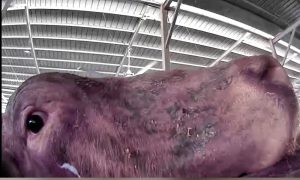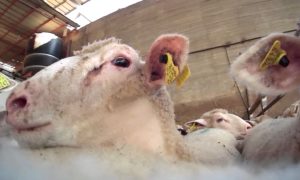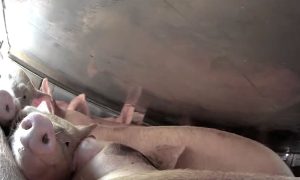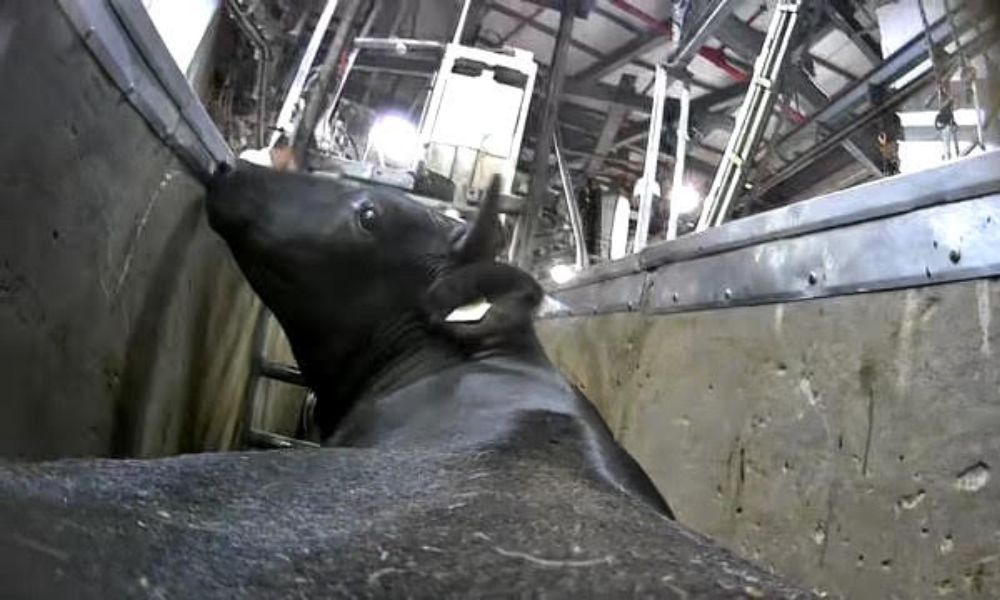The cow’s name was Tomer. His ear tag number was 4702.
Thanks to a new technology that followed Tomer into a slaughterhouse and showed everything from his own point of view, there are things that undercover investigator Ronen Bar now knows.
He knows that Tomer played with his tail and tried to brush his back while transported to slaughter in a tightly-packed, 2-level truck.
He knows that feces fell from the second floor of that truck and covered the cows, including the frightened cow next to Tomer.
He knows that Tomer, unlike many of the other bulls, kept his head held high until the moment he ended up in the slaughter line, listening to the bellowing screams of the cows that went before him.
“Unlike other bulls, who look down fearfully to the floor, Tomer looks straight,” Ronen told Lady Freethinker (LFT). “His head is up, until the slaughter line moves forward, and he constantly looks back.”
This rare glimpse into farmed animals’ last moments on earth was made possible by an innovative technology that Bar and Sentient, an investigative nonprofit based in Israel, pioneered and called “Camera on Animal.”
The technology uses cellular technology to help activists shine a light into the hidden, well-guarded facilities that otherwise are unreachable, Bar said. Activists place tiny, camouflaged cameras capable of live streaming onto animals bound for slaughter and then watch the animals’ final exploitation from their phones.
The technology has exposed criminal animal cruelty in slaughterhouses that has led to convictions but also has allowed people to see farmed animals as individuals, Bar said.
“The footage tells their story, through their eyes, streaming images of their surroundings and the sounds in their environment,” Bar said. “This new method exposes the brutal reality of hidden and sealed facilities. As animal advocates worldwide face challenges, violence, and Ag-gag laws in their attempts to expose the realities inside slaughterhouses, this is a novel way to reveal the truth.”
Answers in the following Q&A have been edited for length.
Activists looking to engage the Camera on Animal technology in their own advocacy or others interested in learning more about or helping with Sentient’s work (they are looking for video editors, designers, PR professionals, fundraisers, and social media experts) can contact the organization via their website here.
A Q&A With Sentient’s Ronen Bar

Ronen Bar (Courtesy of Sentient)
How did you end up becoming an undercover investigator?
As a child, I always had a “green conscience” and an awareness of the environment. After I finished in the Israeli army, I became an investigative journalist and learned more about factory farming. I remember I wanted to do a story about it and I was told I couldn’t, because who was I going to interview? Camera on Animal technology is the answer to that, because every camera is an interview.
I founded the investigations team at Anonymous for Animals (Editorial Note: Now known as Animals Now!) and started work as an undercover investigator. I worked as an undercover investigator in the biggest abattoir in Israel and also a chicken slaughterhouse. It is hard work, but it allows you to stretch the limits of your personality.
Tell us more about how “Camera on Animal” technology fits into the larger animal rights movement.
Our goal is to share valuable knowledge with animal rights activists and promote a worldview that recognizes the individual sentient being as well as the large-scale atrocities. To that end, Camera on Animal is about diversifying the tools that activists can have and use. This tool is not just for (professional) investigators. It’s a tool for every activist who has contact with animals.
The big difference between this and other types of cameras that are out there is that you are always staying with the point of view of the individual animal. You see them offloading from the slaughter truck. You see them in the slaughter line.
Our investigators become very emotionally connected to the animals they watch in this way. We think this connection can create compassion and change. The experience of watching the world from the animal’s perspective is meant to transform how we as a society view these sentient beings.

(Courtesy of Sentient)
How has your undercover footage helped create change for animals?
A good undercover investigation can activate journalists, police, officers, judges, CEOs of large companies, members of government, and even a prime minister or president.
Our investigations have caused a decrease in meat consumption of big brands, temporary shut-downs of slaughterhouses, class action lawsuits, legislation change, and the formation of a special governmental committee.
The investigation at Adom Adom (Editorial Note: footage revealed widespread abuse and illegal use of electric prods) ended up with the first conviction ever of farmed animal abuse in Israel. The two managers were convicted, and the two workers were convicted, and the manager of the whole abattoir was fired during that investigation.
The legal system should do its job, but what is more important is the conviction of the company, and that hasn’t happened in Israel, unfortunately — in class action lawsuits, yes, but not in the criminal sense of the word. The company needs to pay, and the CEO needs to pay; we need to look at the managers.
Another result of the investigations is the public awareness it creates and some acknowledgement by the public that these animals do not have good lives.
Sentient focuses on animals as individuals — why do you feel that is so important?
Millions of animals are slaughtered every single day, and the animal agriculture industry succeeds in eliminating the individual animals from people’s consciousness. The industry gives them a number, and it eliminates their entire personalities.
When I ask people to tell me the story of one specific animal, they can’t (with the exception of one person). And that individual story matters because it creates a connection. So we are trying to reclaim the truth that these animals are individuals.
Every animal who gets a camera gets a name. We want people to connect to the nuance, the small moments, of the animal — like a worker passing by, like they are in the transport truck and you see feces coming down from the upper floor. We wanted to bring people’s attention to those small moments. How does the animal feel when that happens?

Alexa the Sheep(Courtesy of Sentient)
Sentient also equips activists with earrings that resemble the tags forced into farmed animals’ ears — tell us more about that?
We offer them as part of personal outreach advocacy. One side of the tag has the animal’s number, and the other side has the animal’s name. People will ask about it, and then you can explain to them about the individual animal as well as the industry (that exploited the animal). It’s activism just by wearing the tag.
What is the overall environment like for animals and animal rights activists in Israel?
Israeli law forbids abuse to animals, and it does not exclude farmed animals. If the Israeli law was enforced, all of the meat industries would be shut down. But the law and the reality are two different things.
In Israel, there used to be quite a few undercover investigations that would get media attention, but in recent years — not so much. The media is not as interested. The industry has learned how to better protect itself. It’s very hard to get media attention for animals, especially farmed animals. We as animal rights activists have to be more creative and find new ways to bring attention to them.
I think it’s always important to remember that the criminal ones are the ones abusing animals — not the animal rights activists.

(Courtesy of Sentient)
The Sentient website notes the nonprofit is part of the effective altruism movement — can you explain to our readers what you mean by that?
We as activists have to take our career very seriously, and to take it very seriously means we can’t say, ‘Oh, I have a feeling… I want to do that.’ I’m not saying don’t pay attention to your gut — that’s also important — but our sentiment and our feelings are just one parameter. We have to look at the bigger picture. We have to think about the most effective thing to do to improve the world.
Effective altruism thinks in that way, with strategic meetings and conversations about what is effective and what will help the most animals. There are three parameters of effective altruism highlighted, and those are: How big is the scope of the problem? It’s better if you are trying to deal with a problem that is big. The second one is neglectedness: How much effort is being expended in this particular area? If there’s a lot of effort, it’s probably a bit less effective; if there is less effort, it’s probably going to be more effective. The third parameter is tractability, which asks how much we can change this problem.
What’s next for you?
We just launched a KickStarter campaign about SoulScope — a project that’s all about exposing the inner world of animals and turning their individual stories into a powerful force for change. Help us give every animal a name, a story, and a choice to be heard.
Any final thoughts?
We, animal rights activists, are not large in number, and the people promoting animal cruelty (such as in the meat industry) are. Thus, we have to be excellent at flexibility. The cooperation between us must be constantly optimizing.
Our movement currently is not very flexible. We don’t share enough; we don’t have digital platforms that are centralized or standardized where we share information. I hope in the future we will have some centralized place where activists can share their knowledge in a structured manner. Not “Oh, I’m going to send you something,” and I share that information with someone else, like we are in the 1990s.
If we, as animal rights activists, want the movement to grow and to win, we have to be much more flexible than our opponents, and we’re not even close to that. So I think this is the most important thing: Share your knowledge, and see yourself as part of a global community.








